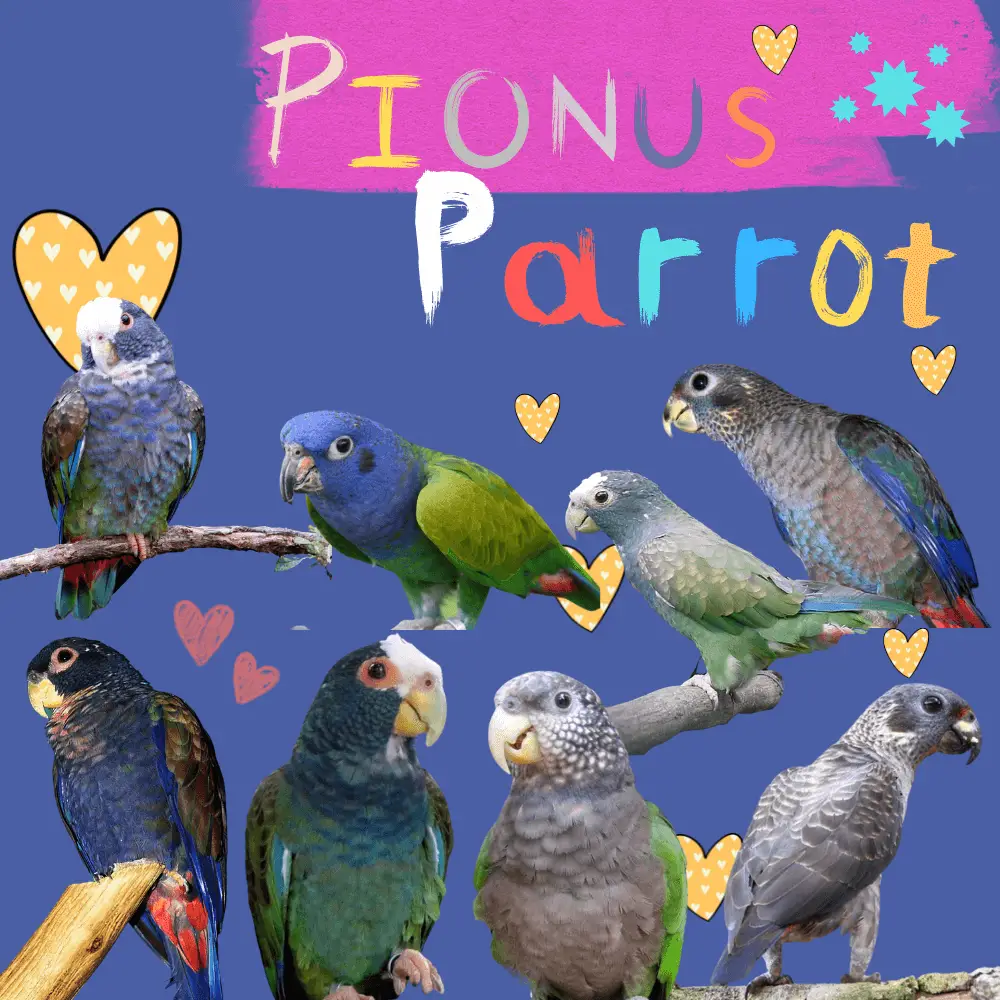The Pionus parrot is a genus in the family of actual parrots ( Psittacidae ). They are among the so-called New World parrots and are very closely related to the Amazon parrots.
The Pionus parrot is a genus of medium-sized parrots that have an average body length of about 28 centimeters. The red under-tail cover gives it its name.
The genus includes eight species, all of which exhibit no sexual dimorphism. Six of the species have a green base color.
In contrast, in the two species, the basic coloring of the body plumage is brown playing into violet. Pionus parrots have a very powerfully built beak.
At the tip of the upper beak, it has pronounced filing notches. The eye rings and the skin of the nose are featherless in all species.
The shape of the body resembles Amazon, but is smaller. Characteristic features of the genus are a straight tail, the length of which is equal to half the wing (the wings do not reach the end of the tail). Undertail red. The bridle is feathered.
Fans are not very popular. This is due to the fact that birds are rarely taken out of their homeland and it is difficult for them to find a pair.
We have different types of Pionus parrots:
Pionus parrot size
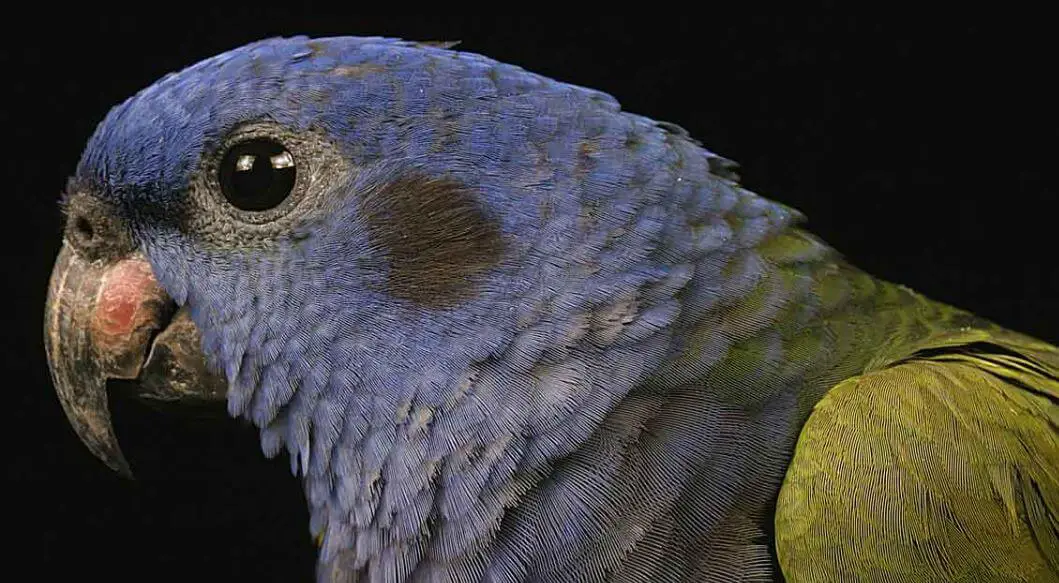
Parrots are characterized by a short, blue tail, an area without feathers around the eyes, and a dark gray beak with red markings on the sides of the jaws. They are similar to parrots of the genus Amazona but smaller.
They occur in Brazil in the northeast region (Maranhão, Piauí, Pernambuco, Alagoas) in the southeast region (Espirito Santo, Minas Gerais, Rio de Janeiro, São Paulo), and south region (Paraná, Santa Catarina, Rio Grande do Sul), passing through the region Midwest (Goiás and Mato Grosso). They also occur in Bolivia, Paraguay, and Argentina.
They live in a variety of habitats that include humid forests, gallery forests, savannas and cultivated areas, up to 2000 meters in altitude.
Generally, they fly in flocks of six to eight individuals, sometimes up to fifty birds when food is very abundant. They usually bathe in lakes to cool off.
Pionus diet
They feed on fruits and seeds, such as Brazilian pine nuts and fig fruits. They also feed on mangoes when they have fruit in formation.
Breeding Pionus parrots
The reproduction of parrots usually occurs from August to January. The couple moves away from the group in search of a hollow formed in the trees.
The female lays three to five white eggs with an incubation period of 23 to 25 days and the male generally remains in the nest during the day.
The chicks are totally dependent on their parents (altricial) and leave the nest at approximately 55 to 60 days old.
Pionus parrot as pet
SOURCE: PippyPets
Pionus parrot types
For those who do not want a noisy bird, the Pionus parrot is ideal. They are gentle, affectionate, and sociable but without being overwhelming.
While waiting for your return, they can very well occupy themselves with their toys. But like all parrots, they will still need affection.
They are obedient birds and easy to tame. On the food side, it is preferable that it is varied.
A grain-only diet is incomplete. He will also need fruits, vegetables, and sprouts. The pionus parrot tends to suffer from a vitamin A deficiency.
It will therefore be necessary to give it green vegetables and orange-colored fruits. What characterizes the pionus parrot is the ” wheezing“.
It’s a sound that resembles that reproduced by people suffering from asthma. Don’t worry, it’s completely normal for a pionus parrot. Their life expectancy is estimated at around 40 years.
Bronze-winged parrot
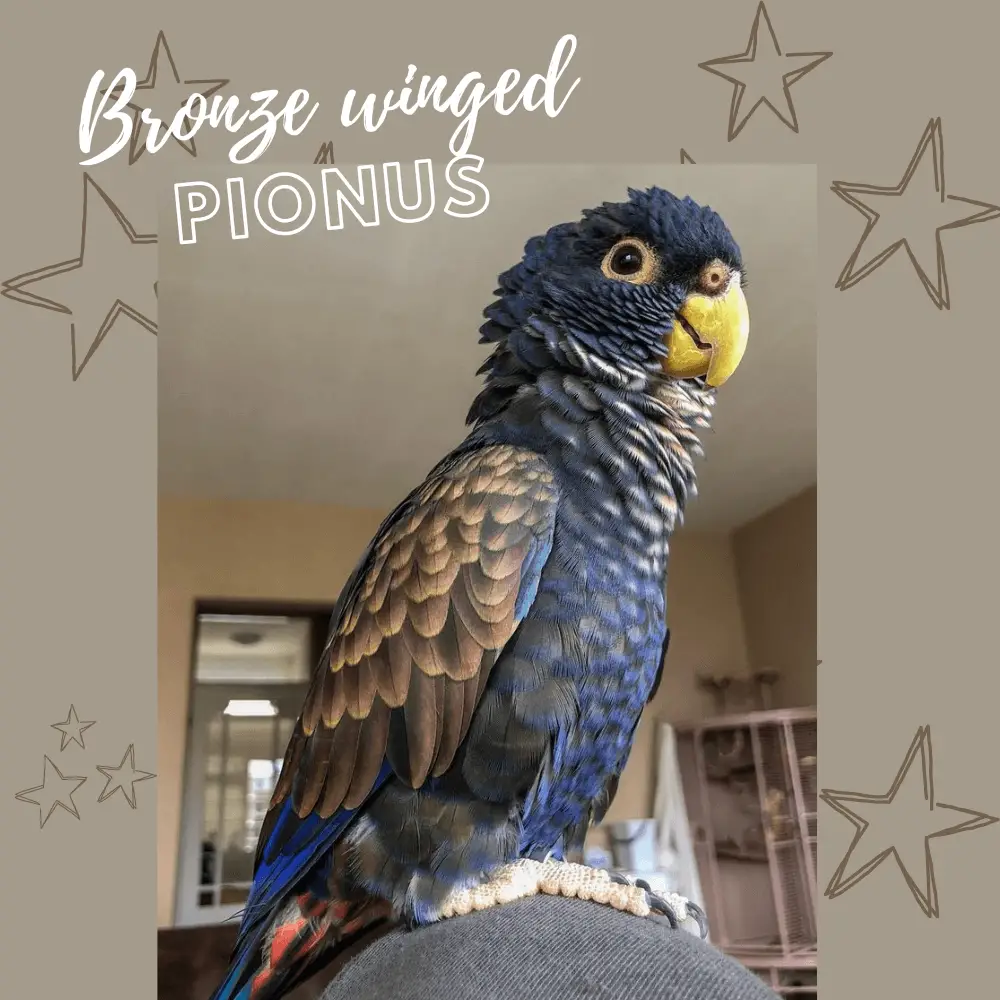
Scientific name: Pionus chalcopterus
Order: Psittaciformes
Family: Psittacidae
Genus: Pionus
Size: 24 to 28 cm
Longevity:
Distribution: Northwestern Venezuela, western Colombia, Ecuador, northwestern Peru Montane forests, in pairs or in small strips
.Manna-blue plumage, spotted with white on the throat. Forehead feathers edged in pink. The underside of the rectrices is red. Pinkish eyering, brighter in nesting season.
Brown eyes. Yellowish beak, brownish-pink legs. Gentle, though skittish, birds that occasionally come to breed in a small garden aviary, although spacious aviaries are generally recommended.
However, success is not guaranteed. As a result of stress, they can prick each other’s heads to the point that after months of separation, the feathers sometimes struggle to grow back. Of a shy nature, he is calm and affectionate.
Depending on his mood, he can bite easily so it is best to have some parrot experience with this species. It is not recommended for children since it does not like turbulence.
Dusky Pionus

Scientific name: Pionus fuscus
Order: Psittaciformes
Family: Psittacidae
Genus: Pionus
Size: 24 cm.
Longevity:
Distribution: Southeastern Venezuela, Guyana, Suriname, French Guiana, and northern Brazil. Small population in northern Colombia. Wooded regions. They are rarely found in open areas.
Description: Some are really brown, while others are more purplish on the belly, others very light in color and some males have a superb silver sheen on their backs.
The Pionus parrot fuscus is an aggressive master in its aviary. Especially during the breeding season, it approaches its caretaker, with its tail feathers wide open, arching its back and raising its neck feathers.
By making as much noise as possible, he is certainly trying to protect his female in this way. There is almost no visual difference between males and females.
The safest way is to use sexing using the analysis of the bird’s DNA, which is carried out using a few feathers. He has the loudest voice among the Pionus parrot, but luckily he rarely uses it.
Maximilian Pionus

Scientific name: Pionus maximiliani
Order: Psittaciformes
Family: Psittacidae
Genus: Pionus
Size: 29 to 31 cm.
Weight: 225 to 275 grams.
Longevity: On average 20 to 25 years, and could reach 40 years.
Distribution: Southeast Brazil and northern Argentina. Clear forest and open wooded areas. In pairs, in small or large flocks: we could see groups of about fifty birds.
Description: It is the largest of the Pionus parrot family. There is a green plumage all in shades, with the head of green feathers edged with light gray. It has a wide mauve throat collar and bare white eye-rings.
The underside of the rectrices is bright red. We see in the adult a few blue feathers at the edge of the tail. Its eyes are brown, its horn-colored beak, and its feet and legs grey. There is no visual difference between males and females.
The safest way is to use sexing by carrying out DNA analysis of the bird, which is carried out using a few feathers.
The pionus parrot is tamed quite easily. It is possible to teach him to whistle a tune and say a few words. Put lots of toys in the crate to stimulate him, and alternate the toys so that he always finds pleasure in them.
They are known to be calm birds and rarely call out. They seek contact since they like to be in your company, but they don’t really like to be held in their hands. They can also serve as an adoptive parent for finicky species.
Subspecies: Pionus maximiliani maximiliani, Pionus maximiliani siy, Pionus bridgesi, Pionus maximiliani melanoblepharus, Pionus maximiliani lacerus.
Blue-headed pionus
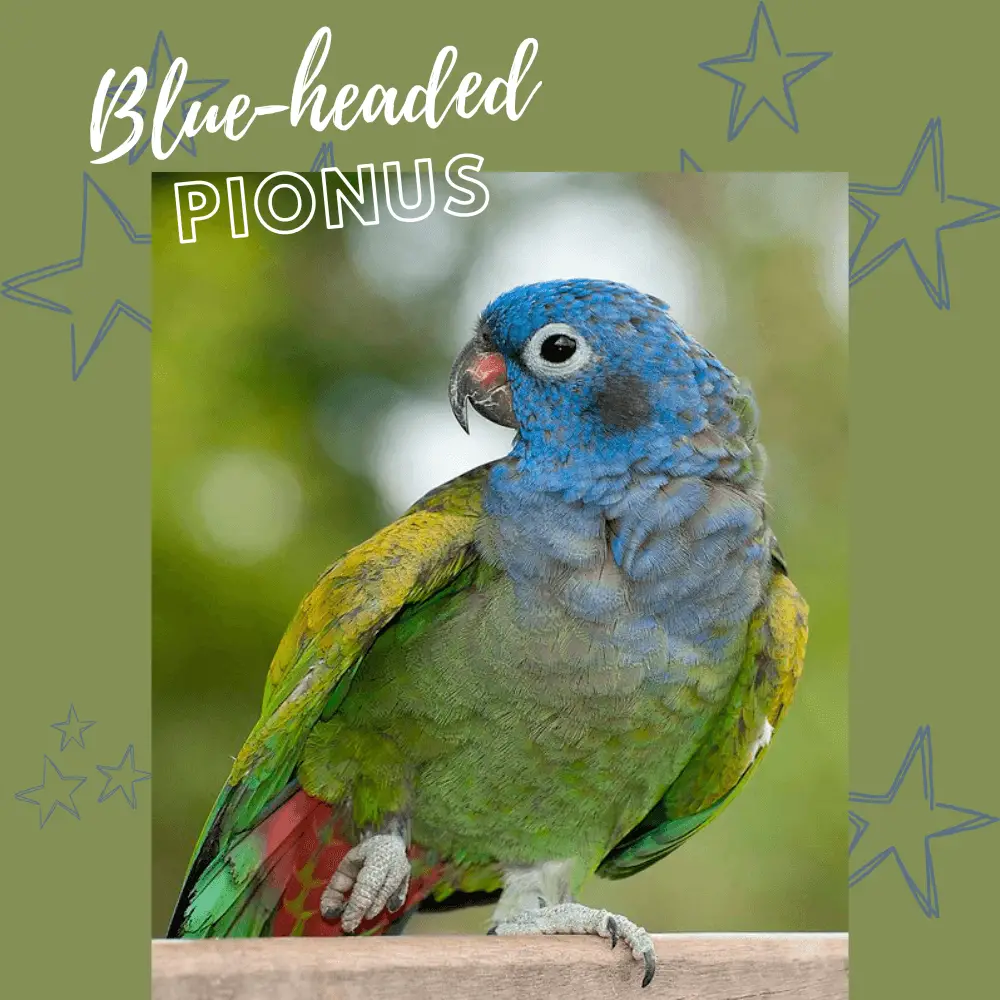
Scientific name: Pionus menstruus
Order: Psittaciformes
Family: Psittacidae
Genus: Pionus
Size: 27 cm.
Longevity:
Distribution: Central and South America: central Brazil, Panama, southern Costa Rica, and northern Bolivia.
Description: Its plumage is predominantly green with a blue head and neck. The eyerings are white and bare. The underside of the rectrices is red and the end of the tail is green.
The eyes are brown, the beak blackish red on the edges, and the feet, and legs greenish gray. Young people are easily tamed and affectionate. Their song is soft and the aviary mates are friendly.
Subspecies: Pionus menstruus menstruus, Pionus menstruus rubrigularis, Pionus menstruus reichenowi, Pionus menstruus chlorocyanescens, Pionus menstruus cyanescens, Pionus cobaltinus.
White-crowned parrot
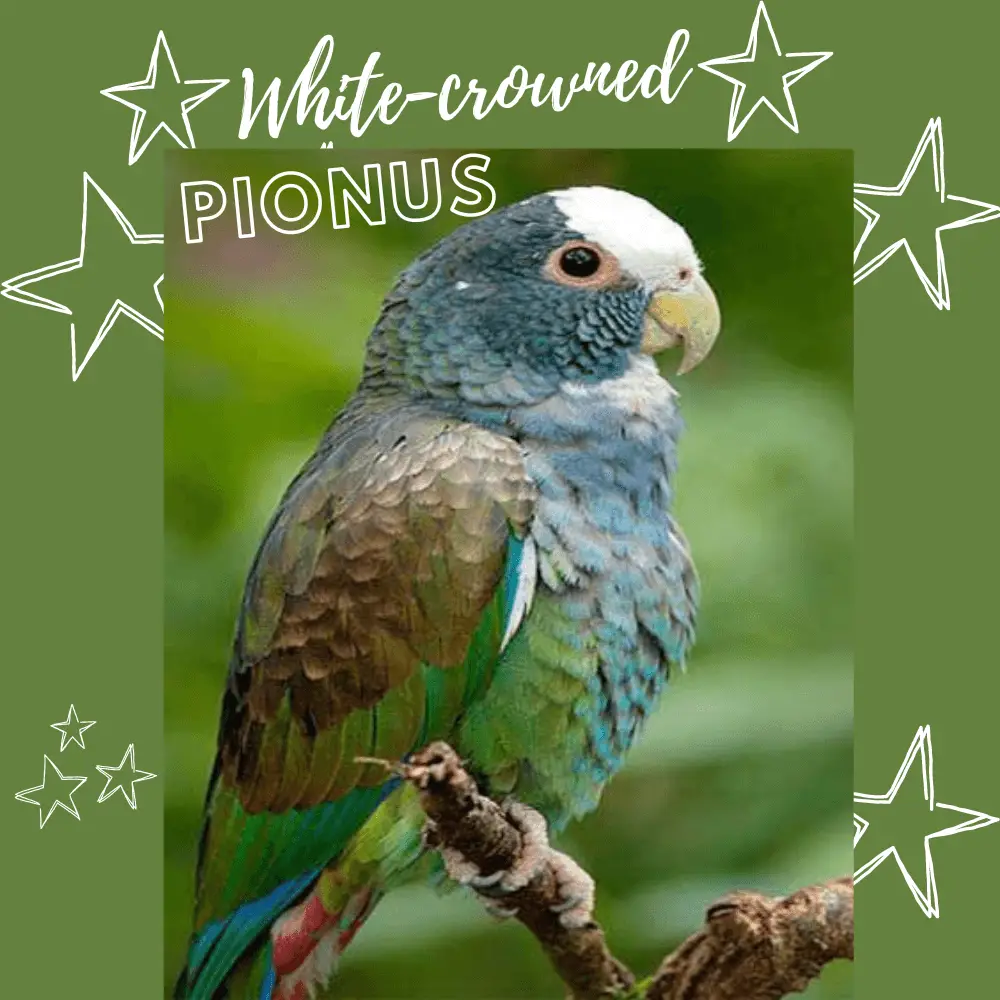
This bird lives on the edge of primary forests and gallery forests, near rivers and wooded savannas.
Pionus senilis is found in Central American countries like Mexico (southeast), Belize, Guatemala, Honduras, Nicaragua, Costa Rica, and Panama.
Description: The plumage has a dominant green adorned with bluish reflections. Forehead, crown, and throat are white. The eye-rings are pink and the irises brown.
The beak and legs are grey. Flight feathers and outer rectrices are blue. A bluish halo is noticeable on the head, neck, and chest while the back is tinged with brown.
The white-crowned parrot is considered an ideal bird in an apartment because it is not very noisy and very calm in nature. He loves receiving affection.
Subspecies: Pionus senilis senilis, Pionus senilis decoloratus (bluer).
Coral-billed pionus
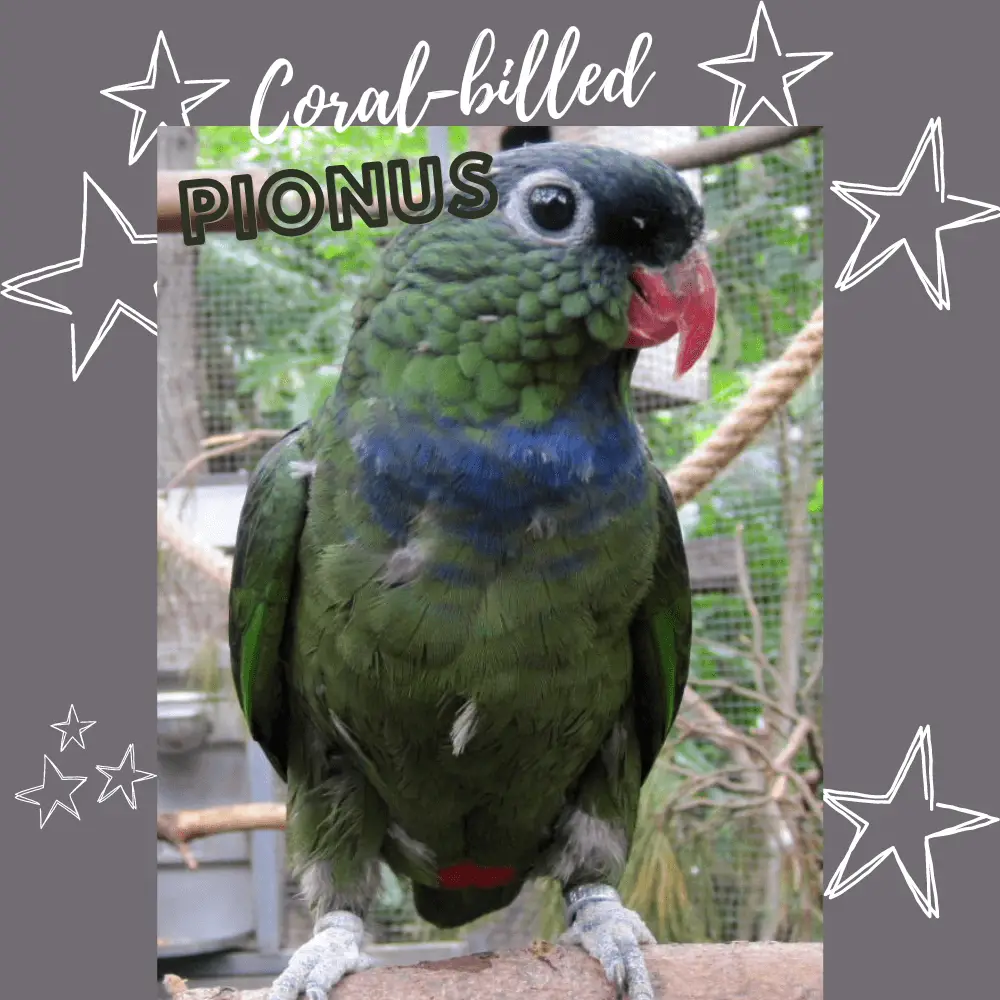
Scientific name: Pionus sordidus
Order: Psittaciformes
Family: Psittacidae
Genus: Pionus
Size: Between 26 and 30 cm.
Longevity:
Distribution: Venezuela, Ecuador, Colombia, Peru, Bolivia.
Description: Generally olive-green in color. Feathers on the crown and back of the head edged dark blue, tips of cheek feathers blue,
blue stripe across the throat and upper breast, breast, and belly dull olive with duller feathers towards the tinged bluish-pink tip, red under tail-coverts,
dull olive-green back with marked olive-brown feathers, green inner tail feathers, blue outer tail feathers with a red base, red bill with a paler base, gray eyering, iris dark brown, gray legs.
Juveniles have a pale green head, yellowish-grey under tail-coverts with some red feathers. There is no visual difference between males and females.
Subspecies: Pionus sordidus sordidus, Pionus sordidus antelius, Pionus sordidus ponsi, Pionus sordidus saturatus, Pionus sordidus corallinus, Pionus sordidus mindoensis .
Plum-crowned parrot
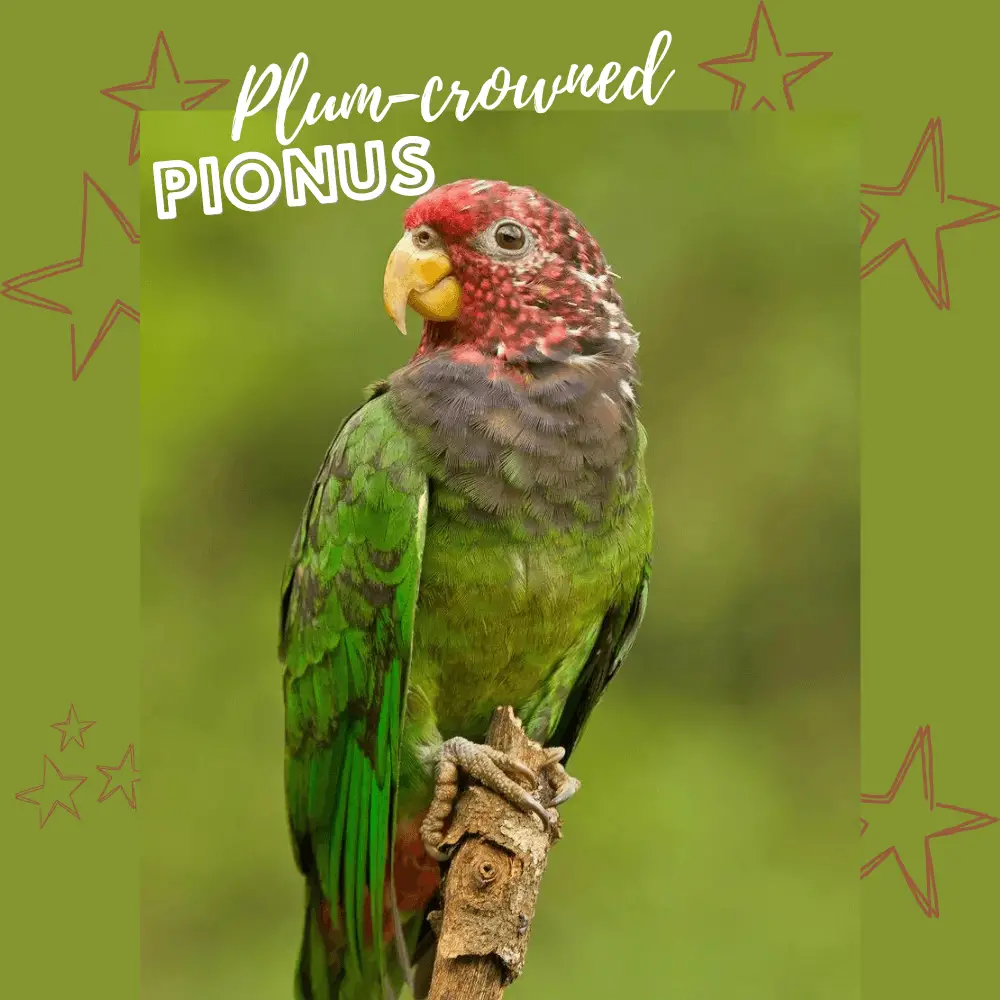
Scientific name: Pionus tumultuosus Order: Psittaciformes Family: Psittacidae
Gender: Pionus
Height: 29 cm.
Longevity:
Distribution: Northwest and central Bolivia, southern Colombia, northwest Venezuela, southwest Amazonia, northwest and eastern Peru.
Description: General color green. Abdomen and flanks yellowish-grey. The Forehead, Dolores, and sides of the head are vinous red with a whitish base of the feathers.
The Crown and back of the head are dark red. The nape, sides of the neck, ears, and chest were purple fading to brownish gray-blue on the chest.
Undertail-coverts red with a yellowish-green edge at the tip. Primary coverts and flight feathers are green, underwings dull green.
Central rectrices green, outer with dull blue-violet tip and red base. Olive-yellow beak. Gray eyering, brown iris. Gray legs.
Immature with green nape, back of crown, throat, cheeks, and breast, yellowish-green undertail-coverts with a pink tip, dark iris. This species is very rare in captivity.
Subspecies: Pionus seniloides.
Pionus parrot Lifestyle
They are found in the tropical rainforests of lowland areas and in the foothills up to an altitude of 2000 m above sea level.
They keep in small groups or flocks, mainly on the tops of trees, but sometimes they also fly into the plantations of grain crops.
Corn fields are particularly affected. The voice of many species of this genus is very loud and sharp. Trying to imitate human speech is rare and unsuccessful.
Pionus parrot price
These medium-sized parrots are very similar to Amazons but slightly smaller. Males and females are indistinguishable.
The average Pionus parrot costs $1,250. However, one can expect to pay over $2,000 for some subspecies.
Blue-headed Pionus
bronze-winged pionus
dark pionus
Maximilian’s Pionus (scaly-headed)
white-headed pionus

